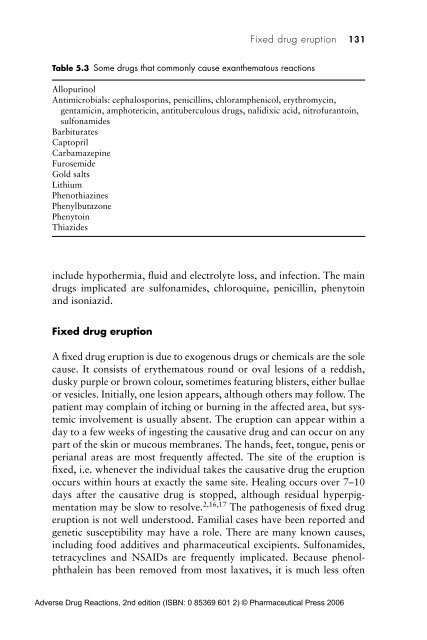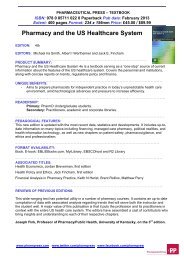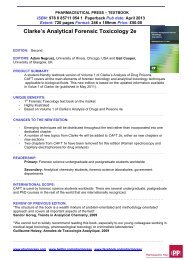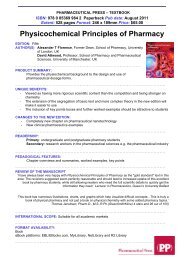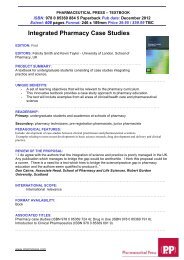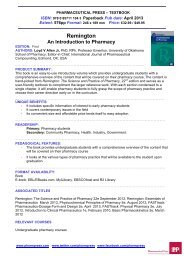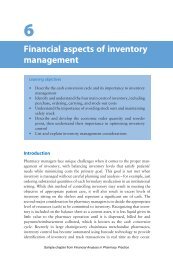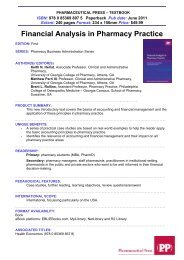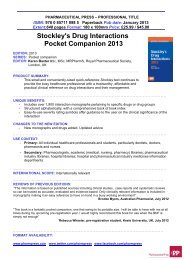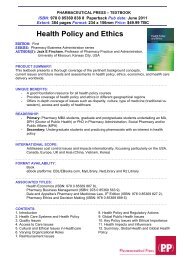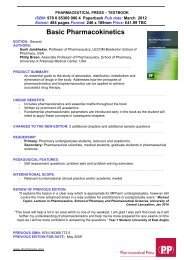Drug-induced skin reactions - Pharmaceutical Press
Drug-induced skin reactions - Pharmaceutical Press
Drug-induced skin reactions - Pharmaceutical Press
Create successful ePaper yourself
Turn your PDF publications into a flip-book with our unique Google optimized e-Paper software.
Fixed drug eruption 131<br />
Table 5.3 Some drugs that commonly cause exanthematous <strong>reactions</strong><br />
Allopurinol<br />
Antimicrobials: cephalosporins, penicillins, chloramphenicol, erythromycin,<br />
gentamicin, amphotericin, antituberculous drugs, nalidixic acid, nitrofurantoin,<br />
sulfonamides<br />
Barbiturates<br />
Captopril<br />
Carbamazepine<br />
Furosemide<br />
Gold salts<br />
Lithium<br />
Phenothiazines<br />
Phenylbutazone<br />
Phenytoin<br />
Thiazides<br />
include hypothermia, fluid and electrolyte loss, and infection. The main<br />
drugs implicated are sulfonamides, chloroquine, penicillin, phenytoin<br />
and isoniazid.<br />
Fixed drug eruption<br />
A fixed drug eruption is due to exogenous drugs or chemicals are the sole<br />
cause. It consists of erythematous round or oval lesions of a reddish,<br />
dusky purple or brown colour, sometimes featuring blisters, either bullae<br />
or vesicles. Initially, one lesion appears, although others may follow. The<br />
patient may complain of itching or burning in the affected area, but systemic<br />
involvement is usually absent. The eruption can appear within a<br />
day to a few weeks of ingesting the causative drug and can occur on any<br />
part of the <strong>skin</strong> or mucous membranes. The hands, feet, tongue, penis or<br />
perianal areas are most frequently affected. The site of the eruption is<br />
fixed, i.e. whenever the individual takes the causative drug the eruption<br />
occurs within hours at exactly the same site. Healing occurs over 7–10<br />
days after the causative drug is stopped, although residual hyperpigmentation<br />
may be slow to resolve. 2,16,17 The pathogenesis of fixed drug<br />
eruption is not well understood. Familial cases have been reported and<br />
genetic susceptibility may have a role. There are many known causes,<br />
including food additives and pharmaceutical excipients. Sulfonamides,<br />
tetracyclines and NSAIDs are frequently implicated. Because phenolphthalein<br />
has been removed from most laxatives, it is much less often<br />
Adverse <strong>Drug</strong> Reactions, 2nd edition (ISBN: 0 85369 601 2) © <strong>Pharmaceutical</strong> <strong>Press</strong> 2006


